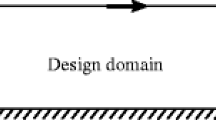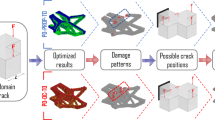Abstract
This paper extends the independent point-wise density interpolation to the bi-material topology optimization to improve the structural static or dynamic properties. In contrast to the conventional elemental density-based topology optimization approaches, this method employs an analysis-mesh-separated material density field discretization model to describe the topology evolution of bi-material structures within the design domain. To be specific, the density design variable points can be freely positioned, independently of the field points used for discretization of the displacement field. By this means, a material interface description of relatively high quality can be achieved, even when unstructured finite element meshes and irregular-shaped elements are used in discretization of the analysis domain. Numerical examples, regarding the minimum static compliance design and the maximum fundamental eigen-frequency design, are presented to demonstrate the validity and applicability of the proposed formulation and numerical techniques. It is shown that this method is free of numerical difficulties such as checkerboard patterns and the “islanding” phenomenon.















Similar content being viewed by others
References
Bendsøe MP, Kikuchi N. Generating optimal topologies in structural design using a homogenization method. Comput Methods Appl Mech Eng. 1988;71:197–224.
Bendsøe MP. Optimal shape design as a material distribution problem. Struct Optim. 1989;1:193–202.
Rozvany GI, Zhou M, Birker T. Generalized shape optimization without homogenization. Struct Optim. 1992;4:250–2.
Bendsøe MP, Sigmund O. Material interpolation schemes in topology optimization. Arch Appl Mech. 1999;69:635–54.
Xie Y, Steven G. Evolutionary structural optimization for dynamic problems. Comput Struct. 1996;58:1067–73.
Allaire G, Jouve F, Toader AM. Structural optimization using sensitivity analysis and a level-set method. J Comput Phys. 2004;194:363–93.
Wang MY, Wang X, Guo D. A level set method for structural topology optimization. Comput Methods Appl Mech Eng. 2003;192:227–46.
Luo Z, Wang MY, Wang S, Wei P. A level set-parameterization method for structural shape and topology optimization. Int J Numer Methods Eng. 2008;76:1–26.
Luo Z, Tong L, Kang Z. A level set method for structural shape and topology optimization using radial basis functions. Comput Struct. 2009;87:425–34.
Zhou S, Li W, Li Q. Level-set based topology optimization for electromagnetic dipole antenna design. J Comput Phys. 2010;229:6915–30.
Bruns TE. Topology optimization of convection-dominated, steady-state heat transfer problems. Int J Heat Mass Transf. 2007;50:2859–73.
Jeong SH, Choi DH, Yoon GH. Fatigue and static failure considerations using a topology optimization method. Appl Math Model. 2015;39:1137–62.
Makihara K, Takezawa A, Shigeta D, Yamamoto Y. Power evaluation of advanced energy-harvester using graphical analysis. Mech Eng J. 2015;2:14–00444.
Thomsen J. Topology optimization of structures composed of one or two materials. Struct Optim. 1992;5:108–15.
Sigmund O. Design of multiphysics actuators using topology optimization-part II: two-material structures. Comput Methods Appl Mech Eng. 2001;190:6605–27.
Luo Y, Kang Z. Layout design of reinforced concrete structures using two-material topology optimization with Drucker–Prager yield constraints. Struct Multidiscip Optim. 2013;47:95–110.
Sun S, Zhang W. Multiple objective topology optimal design of multiphase microstructures. Acta Mech Sin. 2006;38:633–8.
Sun S, Zhang W. Investigation of perimeter control methods for structural topology optimization with multiphase materials. Hangkong Xuebao/Acta Aeronautica et Astronautica Sinica. 2006;27:963–8.
Molter A, Fonseca J, Fernandez L. Simultaneous topology optimization of structure and piezoelectric actuators distribution. Appl Math Model. 2016;40:5576–88.
Gao T, Zhang W. A mass constraint formulation for structural topology optimization with multiphase materials. Int J Numer Methods Eng. 2011;88:774–96.
Stegmann J, Lund E. Discrete material optimization of general composite shell structures. Int J Numer Methods Eng. 2005;62:2009–27.
Long K, Wang X, Gu X. Multi-material topology optimization for the transient heat conduction problem using a sequential quadratic programming algorithm. Eng Optim. 2018;50:2091–107.
Huang X, Xie Y. Bi-directional evolutionary topology optimization of continuum structures with one or multiple materials. Comput Mech. 2009;43:393–401.
Radman A, Huang X, Xie Y. Topological design of microstructures of multi-phase materials for maximum stiffness or thermal conductivity. Comput Mater Sci. 2014;91:266–73.
Sethian JA, Wiegmann A. Structural boundary design via level set and immersed interface methods. J Comput Phys. 2000;163:489–528.
Wang MY, Wang X. Color level sets: a multi-phase method for structural topology optimization with multiple materials. Comput Methods Appl Mech Eng. 2004;193:469–96.
Zhou P, Du J, Lü Z. A generalized DCT compression based density method for topology optimization of 2D and 3D continua. Comput Methods Appl Mech Eng. 2018;334:1–21.
Antonietti PF, Bruggi M, Scacchi S, Verani M. On the virtual element method for topology optimization on polygonal meshes: a numerical study. Comput Math Appl. 2017;74(5):1091–109.
Kang Z, Wang Y. Structural topology optimization based on non-local Shepard interpolation of density field. Comput Methods Appl Mech Eng. 2011;200:3515–25.
Kang Z, Wang Y. A nodal variable method of structural topology optimization based on Shepard interpolant. Int J Numer Methods Eng. 2012;90:329–42.
Wang Y, Kang Z, He Q. Adaptive topology optimization with independent error control for separated displacement and density fields. Comput Struct. 2014;135:50–61.
He Q, Kang Z, Wang Y. A topology optimization method for geometrically nonlinear structures with meshless analysis and independent density field interpolation. Comput Mech. 2014;54:629–44.
Pedersen NL. Maximization of eigenvalues using topology optimization. Struct Multidiscip Optim. 2000;20:2–11.
Jensen JS. Topology optimization of dynamics problems with Padé approximants. Int J Numer Methods Eng. 2007;72:1605–30.
Svanberg K. The method of moving asymptotes—a new method for structural optimization. Int J Numer Methods Eng. 1987;24:359–73.
Du J, Olhoff N. Minimization of sound radiation from vibrating bi-material structures using topology optimization. Struct Multidiscip Optim. 2007;33:305–21.
Pedersen NL, Nielsen AK. Optimization of practical trusses with constraints on eigenfrequencies, displacements, stresses, and buckling. Struct Multidiscip Optim. 2003;25:436–45.
Jensen JS, Pedersen NL. On maximal eigenfrequency separation in two-material structures: the 1D and 2D scalar cases. J Sound Vib. 2006;289:967–86.
Gao T, Zhang W. A mass constraint formulation for structural topology optimization with multiphase materials. Int J Numer Methods Eng. 2011;88(8):774–96.
Luo Y, Kang Z, Yue Z. Maximal stiffness design of two-material structures by topology optimization with nonprobabilistic reliability. AIAA J. 2012;50:1993–2003.
Acknowledgements
The financial support of the National Natural Science Foundation of China (11425207, U1508209) is gratefully acknowledged.
Author information
Authors and Affiliations
Corresponding author
Rights and permissions
About this article
Cite this article
Suo, X., Kang, Z., Zhang, X. et al. Bi-material Topology Optimization Using Analysis Mesh-Independent Point-Wise Density Interpolation. Acta Mech. Solida Sin. 32, 698–712 (2019). https://doi.org/10.1007/s10338-019-00142-2
Received:
Revised:
Accepted:
Published:
Issue Date:
DOI: https://doi.org/10.1007/s10338-019-00142-2




